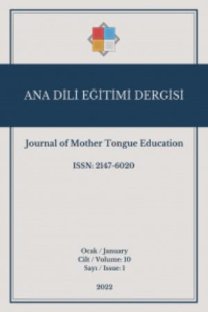Derin Anlamın Kurucu Öğesi Olarak Duygusal Anlam: Yazın Öğretimi Temelli Bir Bakış
Emotional Meaning as a Constituent of Deep Meaning: A View Based on Lİterature Teaching
___
- Aksan, M. (2006). Metaphors of anger: an outline of a cultural model, Mersin Üniversitesi, Journal of Linguistics and Literature, 3(1), s. 31-67.
- Bıçakçı, B. (2015). Aramızdaki en kısa mesafe. İstanbul: İletişim Yayınları.
- Bower, G. (1992). How might emotions affect learning? S. A. (Ed.) The handbook of emotion and memory, Christianson, New York: Psychology Press, s.3-33.
- Bublitz, W. (1978). Ausdrucksweisen der Sprechereinstellung im Deutschen und Englischen. Untersuchungen zur Syntax, Semantik und Pragmatik der deutschen Modalpartikeln und Vergewisserungsfragen und ihrer englischen Entsprechungen. Linguistische Arbeiten 57, Tübingen: Niemeyer.
- Durst, U. (2001). Why Germans don’t feel anger. Harkins, J. und Wierzbicka, A. (Ed.) Emotions in crosslinguistic perspective. Berlin: de Gruyter, s. 115-148.
- Eco, U. (1979). A theory of semiotics. Bloomington: Indiana University Press
- Ekman, P. (1972). Universals and cultural differences in facial expression of emotion. Cole, J.K. (Ed.) Nebraska Symposium on Motivation. Lincoln: Univ. Of Nebraska Press, s. 207-283.
- Ekman, P. (1988). Gesichtsausdruck und Gefühl. 20 Jahre Forsschung von Paul Ekman, Paderborn: Junfermann.
- Fiehler, R. (1990). Kommunikation und Emotion. Theoretische und empirische Untersuchungen zur Rolle von Emotionen, Berlin: de Gruyter.
- Fries, N. (1991). Emotionen. Experimentalwissenschaftliche und linguistische Aspekte, in: Sprache und Pragmatik 23, s. 32–70.
- Fries, N. (1996). Grammatik und Emmotionen. In Zeitschrift für Literaturwissenschaft und Linguistik. LiLi 26, s. 37-69.
- Fries, N. (2000). Sprache und Emmotion. Ausführungen zum besersen Verständnis, Anregungen zum Nachdenken. Bergisch Gladbach, BLT.
- Hartmanns, F. (2002). Dimension der Bedeutung: Aspekte der Emotion. Cruse, D. A. (Ed.) Lexikologie, Band 1. Berlin: de Gruyter, s. 356-362.
- Huber, M. ve Winko S. (2009). Literatur und Kognition. Bestandsaufnahmen und Perspektiven eines Arbeitsfeldes. Paderborn: Mentis.
- Izard, C.E. (1994). Innate and universal facial expressions: Evidence from developmental and cross-cultural research. Psychological Bulletin, 115(2), s. 288-299.
- Jahr S. (2000). Emotionen und Emotionsstukturen in Sachtexten. Berlin: Walter de Gruyter.
- Jäger L. ve Plum S. (2014). Text und Emotion, Tübingen: Narr Verlag.
- Kasper G. (1981). Pragmatische Aspekte in der Interimsprache: eine Untersuchung des Englischen, Tübingen: Narr Verlag.
- Kövecses, Z. (1999). Methaphor and emotion: Language, culture and body in human feeling. Cambridge: Cambridge Univ. Press.
- Lakoff, G. ve Kövecses, Z. (1987). The cognitive model of anger inherent in American English. D. Holland and N. Quinn (Ed.). Cultural models in language and thought. Cambridge: Cambridge Univ. Press., s. 195-222.
- Lazarus, R.S. (1982). Thoughts on the relations between emotion andcognition. American Psychologist, 37, s. 1019-1024.
- Lindsley, CH. H. (1951). The ıntrinsic viscosity of nitrocellulose. Journal of Polymer Science, 7(6), New York: s. 635-652.
- Osgood, C. E. (1957). The measurement of meaning. Urbana: Univ. Of İllinois Press.
- Sandhöfer-Sixel, J. (1990). Emotionale bewertung als modale kategorie. K. Sornig, und N. Denison. (Ed). Sprache: Emotion. Graz, Grazer linguistische Studien, 33/34, s. 267-278.
- Schlaeger J. ve Stedman G. (1999). Representations of emotions. Literatur und Anthropologie 3, Tübingen: Gunter Narr.
- Schwarz-Friesel, M. (2007). Sprache und emotion. Tübingen: A. Francke.
- Schwarz-Friesel, M. (2008). Sprache, kognition und emotion: Neue wege in der kognitionswissenschaft, sprache, kognition, kultur. H. Kämper. und L. M. Eichinger (Ed.) Berlin: de Gruyter, s. 263-276.
- Soysal, S. (1982). Hoş geldin ölüm. Ankara: Bilgi Yayınevi.
- Temelkuran, E. (2013). Düğümlere Üfleyen Kadınlar. İstanbul: Everest Yayınları.
- Ümit, A. (2015). Elveda güzel vatanım. İstanbul: Everest Yayınları.
- Wierzbicka, A. (1999). Emotion across languages and cultures: Diversity and universals. Cambridge: Cabridge Univ. Press.
- Winko, S. (2003). Über Regeln emotionaler Bedeutung in und von literarischen Texten, Regeln der Bedeutung, Jannidis, F. und S. Winko (Ed.), Berlin: Walter de Gruyter, s. 329-348.
- ISSN: 2147-6020
- Yayın Aralığı: 4
- Başlangıç: 2013
- Yayıncı: Mehmet Kurudayıoğlu
Türkçede Pekiştirme Sıfatlarına Eleştirisel Bir Bakış
Dil Eğitimi Araştırmaları İçin Bir Değişken Önerisi: Kelime Hazinesi Katsayısı
Veli ve Öğretmen Gözüyle İlkokul Öğrencilerinde Yazı Okunaklılığı
YASEMİN KUŞDEMİR, MEHMET KATRANCI, FATİH ARSLAN
Türkçe Eğitimi Alanında Yapılan Doktora Tezlerinin İncelenmesi
Sümeyra BOYACI, Selmi DEMİRKOL
Derin Anlamın Kurucu Öğesi Olarak Duygusal Anlam: Yazın Öğretimi Temelli Bir Bakış
Türkiye Türkçesinde Tezlik Bildiren Bir Özel Yapı Üzerine
Eylül Romanında Aşkı Hazırlayan Ortam ve Unsurlar
A Discussion of the Ins and Outs of L2 Pronunciation Instruction: A Clash of Methodologies
